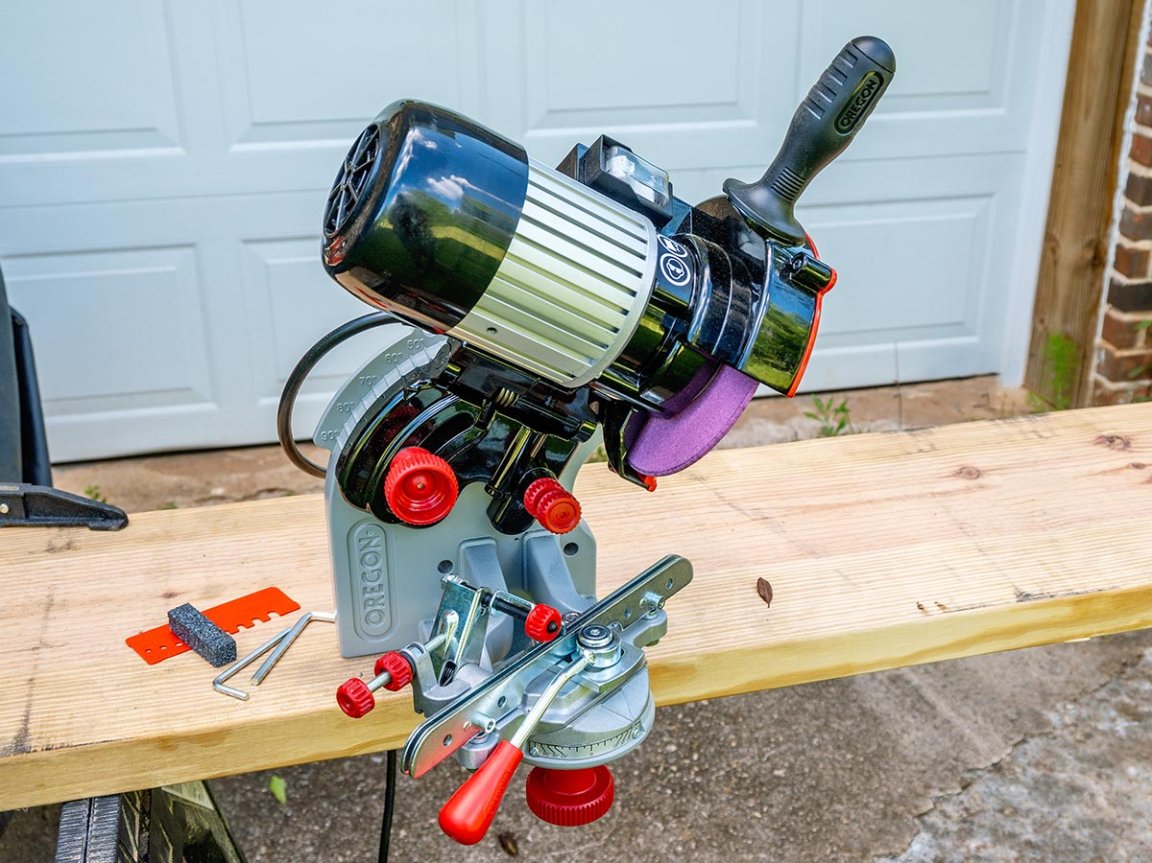We may earn revenue from the products available on this page and participate in affiliate programs. Learn More ›
When our product reviews team set out to identify the best chainsaw sharpener, we zeroed in on the idea of “proper” sharpening. The ideal tool would make it easy to keep saw chains sharp, maintain the proper chisel angles and depth of cut, and remove an equal amount of metal with each pass. This tool would also need to be adjustable because intensive chainsaw users tend to own several saws with different chain types and pitches. After testing eight different tools, we named the Oregon 410-120 bench grinder chain sharpener the “Best Overall.” In this review, I outline the functionality of the sharpener, discuss its ideal use cases, and offer my observations from testing it.
Oregon Tool introduced the modern “chipper” saw chain back in 1947, and it has led the industry ever since. Over the years the company added products and accessories to support its customers’ needs, including a full complement of sharpeners, from files and filing jigs to handheld electric sharpeners as well as bench and wall-mounted systems. The Oregon 410-120 chainsaw sharpener is a midsize, value-priced bench grinder that is ideal for personal or professional workshops.
Oregon 410-120 Bench Grinder Chain Sharpener: At a Glance
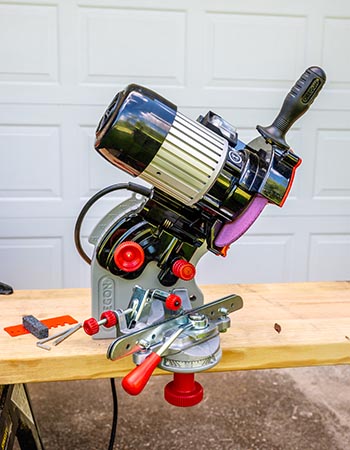
Rating: 4.8/5
SPECS
- Mounting options: Benchtop or wall
- Compatible chain pitches: ¼-inch, ⅜-inch low profile, 0.325-inch, full profile ⅜-inch, and 0.404-inch pitches
- Chain feed and lock: Manual
- Grinding wheel sizes: 3.2mm, 4.7mm, and 6mm thicknesses; 5¾-inches diameter
- Motor specs: 120V, 60Hz, 2.1A single-phase motor
- Grinder RPM: 3,150
PROS
- Saves time and money otherwise spent on professional chain sharpening
- Precise, repeatable results prolong chain life compared to filing only
- Compatible with all saw chain types, up to 0.404-inch pitch
- Adjustment controls are conveniently placed and hold securely
CONS
- More expensive than some comparable bench-mounted chain grinders
- Chain must be removed from the saw to use this sharpener
- Not a replacement for a portable field sharpening kit
Get the Oregon 410-120 bench grinder chain sharpener at:
What is the Oregon 410-120 bench grinder chain sharpener?
Avid chainsaw users know that a properly sharpened chain saves time and money. A sharp chain makes work safer and easier, enhances fuel efficiency, and minimizes wear and tear on the saw. Many saw operators use round files or other portable sharpeners to touch up their chains in the field, then hire a local hardware store or small-engine repair shop for occasional chain reconditioning. The Oregon 410-120 is a benchtop chain grinder that allows anyone to sharpen saw chains in their own workshop and get professional results.
Oregon’s compact bench grinder chain sharpener can be mounted either on a horizontal or vertical surface using the predrilled holes in the base and rear of the unit. It features a pivoting chain vice and adjustable pull-down grinder head that allow users to lock in their desired chisel angle, chisel bevel, and depth of grind. The chain vice includes an adjustable stop that works with any chain pitch, and a manual locking lever secures each cutter while grinding.
For testing, I used the Oregon 410-120 to sharpen a couple of ⅜-inch low-profile chains. The first chain was old, unevenly worn, and in need of reconditioning. The second one was dull but newer, and it was in pretty good shape. After years of hand filing, I found that the Oregon bench grinder did a really nice job renewing the older chain. By working incrementally, I was able to sharpen and size all of the cutters evenly to get the depth gauges back to spec. On the newer chain, it took me less than 5 minutes to set up the grinder settings and sharpen the chain to like-new condition.
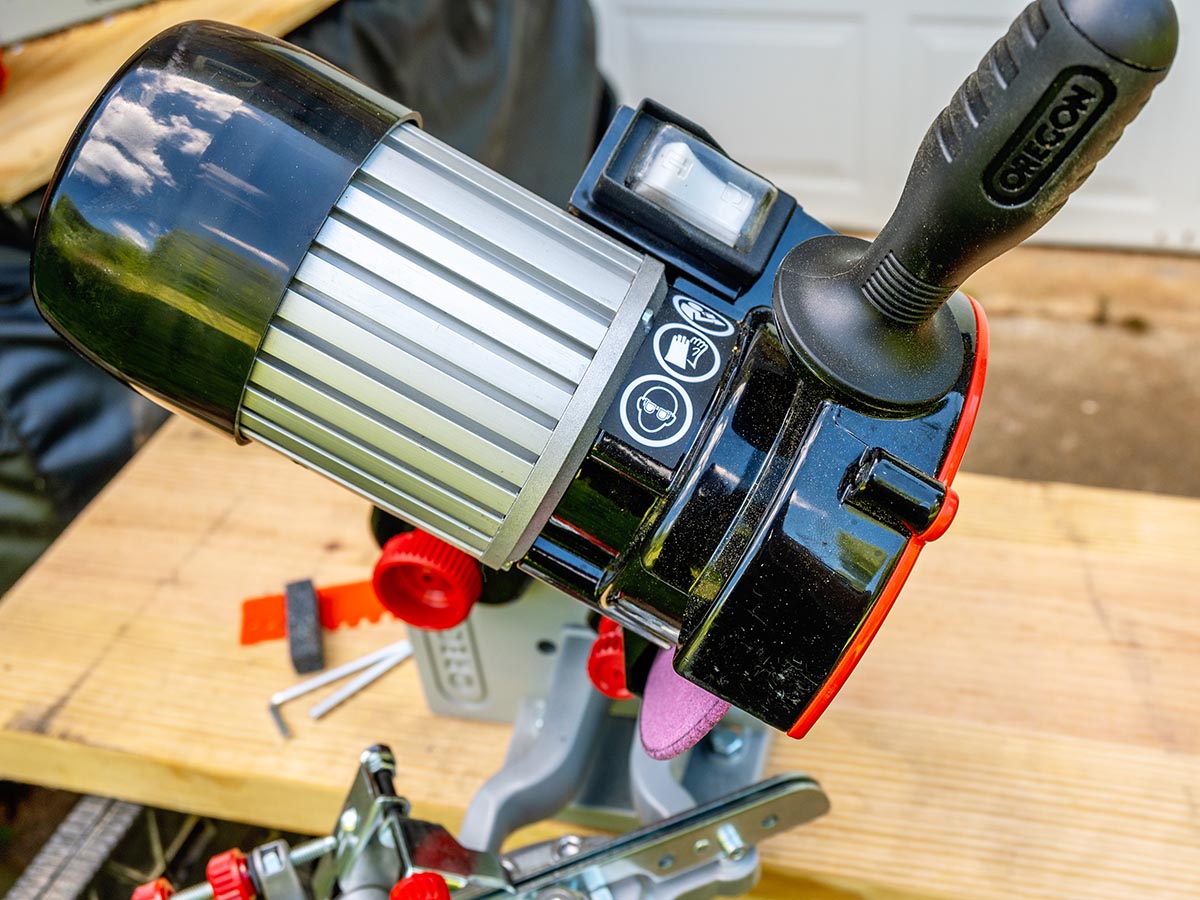
Fast and Easy Assembly
Before getting started, I had to decide where to mount the grinder. I initially set it up for testing on the edge of my workbench, but I later moved it to a wall for better workflow. In both locations, it was a simple matter of marking the location, predrilling two holes, and installing the base with carriage bolts (bolts not included). Then I attached the grinder head by inserting the pivot hub into the base and installing the tilt adjustment bolt. The whole process only took about 10 minutes.
Both setups worked well, but I preferred the wall configuration because it was more comfortable for me. I mounted the grinder at chest height on the wall. This allowed me to comfortably operate the grinder and see the cutters clearly while working, without bending. To keep things organized, I hang dull saw chains on a nail to the left of the grinder, then move them to another nail on the right side of the grinder after sharpening. With this arrangement I can sharpen four or five chains in about 15 minutes.
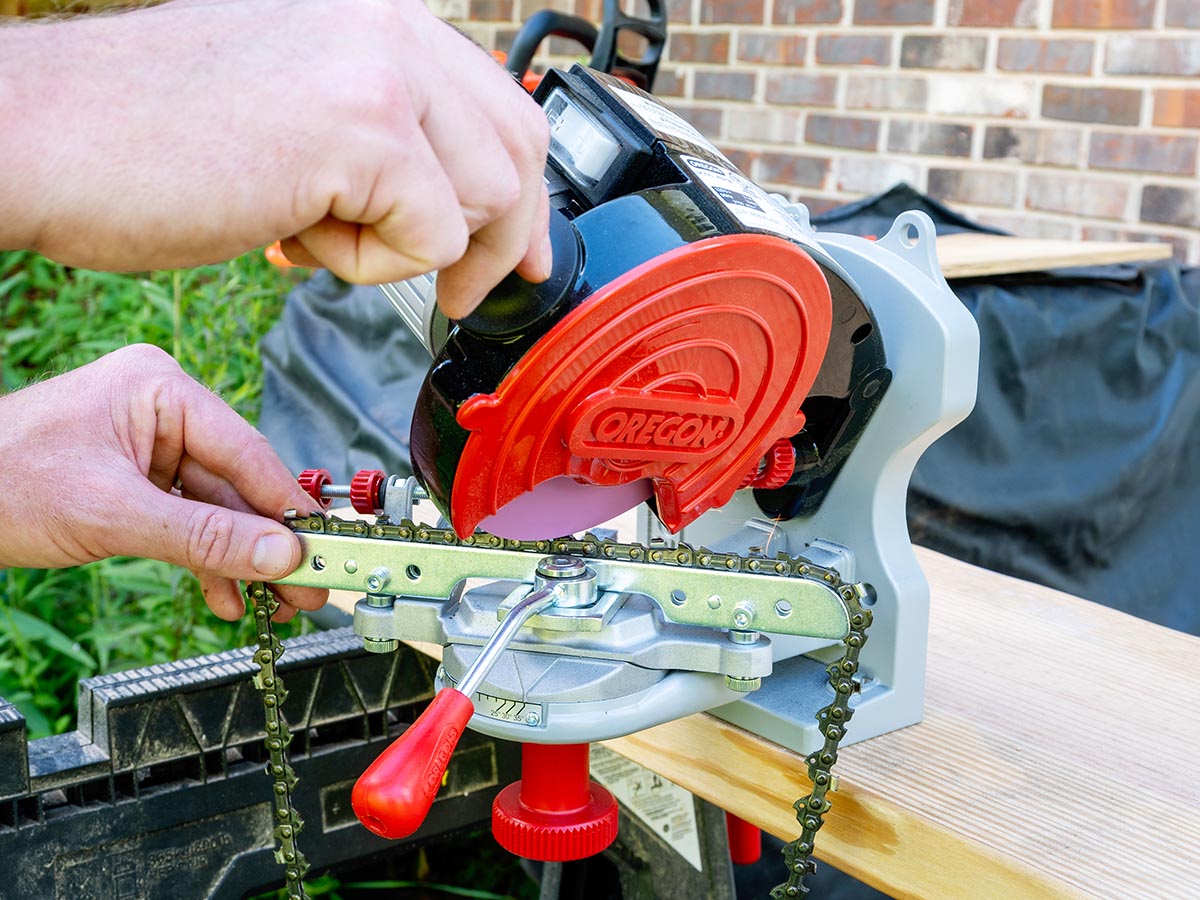
Smooth and Accurate Operation
Operating the Oregon sharpener was simple, but it required several adjustments that took a few moments to set up. Before installing a chain, I chose and installed the right-size grinding wheel for the chain. I installed the chain in the vice and adjusted the chisel angle by pivoting the vice to the left. Next I adjusted the chisel bevel by tilting the pull-down head. Then I adjusted the cutter stop so that the face of the chisel would barely make contact with the face of the grinding wheel. Finally, I adjusted the grinder depth stop bumper by turning the bolt located on the back of the base plate so that the grinding wheel would just skim the cutter trough.
After making all of the adjustments, I turned the lock lever to secure the first cutter in the vice, powered up the grinder, and eased the head down. I felt very little resistance, and a few sparks flew as the wheel contacted the cutter—everything seemed to be lining up as expected. I released the lock, advanced the chain to the next cutter, and eased the head down again. The results were identical. After completing all of the cutters on that side of the chain, I pivoted the base to sharpen the opposite cutters, leaving the rest of the adjustments as they were, and ground the remaining cutters.
In order to adjust the chain depth gauges, I had to install the largest (¼-inch) grinding wheel, reset the chain vice angle to 90 degrees, reset the head-tilt angle to 75 degrees, adjust the cutter stop to align the chain depth gauges with the grinding wheel, and adjust the grinder depth stop to match the desired height of the chain depth gauges. The first time I worked through this process, I also had to calibrate the edge of the grinding wheel with the dressing stone.
In my experience, the tool appears more complicated than it actually is. The adjustments only took a minute or two, and the tool allowed me to completely renew my saw chains with only 2 or 3 minutes of grinding.
Professional Results
After assembling the grinder and figuring out the adjustments, it only took a few minutes to sharpen each saw chain. Once I’d learned how to use the tool on the first chain, I was able to obtain results equal to or better than what I’ve gotten from my local hardware store, and I didn’t have to drive to town and wait in line. I could not have been more satisfied.
The chains I sharpened with the Oregon 410-120 chainsaw sharpener cut better than the ones I’ve only sharpened with a file. All of the cutters are identical in angle, bevel, and depth gauge height, whereas those on my hand-sharpened chains show slight variations. The chainsaw cuts smoothly, produces well-formed chips instead of fine sawdust, and seems to cut longer between fill-ups. It’s a better-quality sharpness.
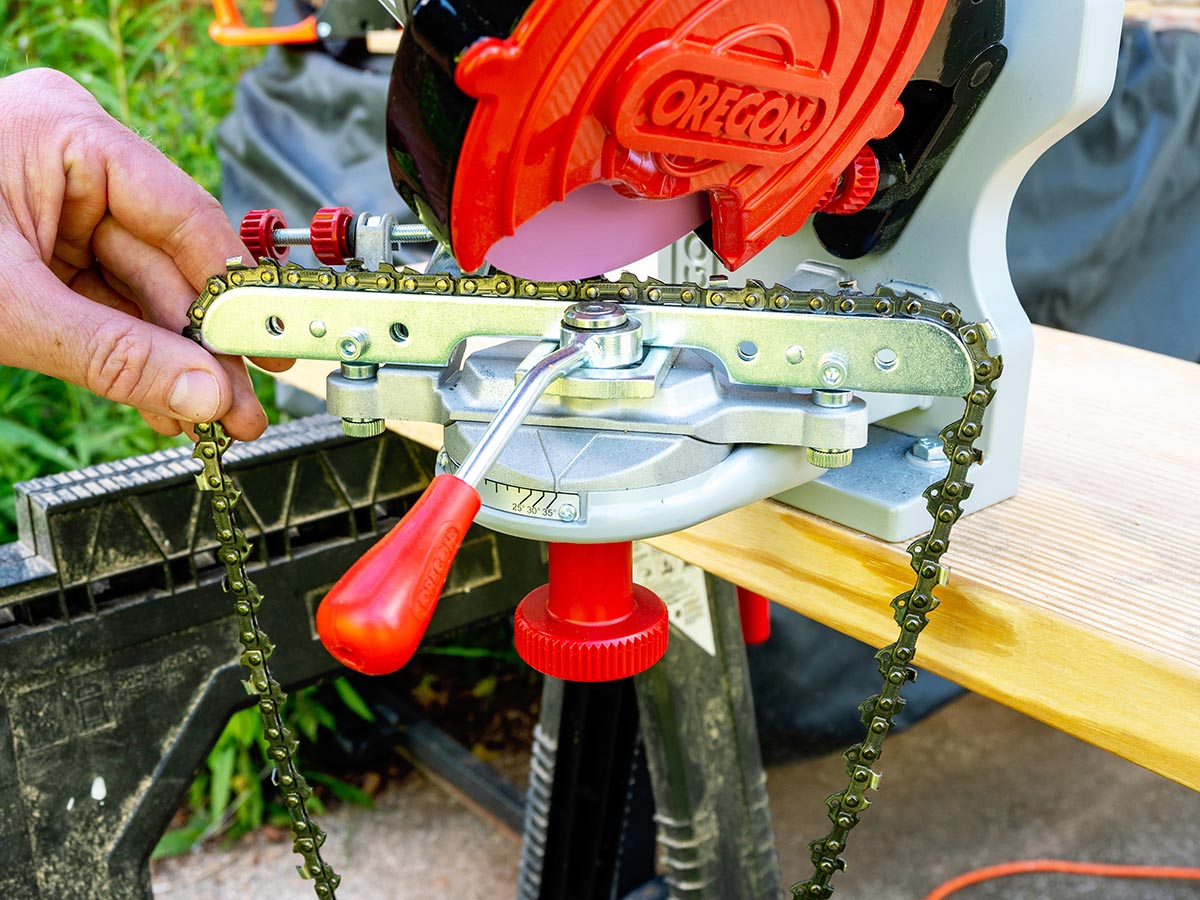
Is the Oregon 410-120 chain sharpener worth the money?
The Oregon bench chain sharpener is well constructed, powerful, and easy to use. The motor ran smoothly and very quietly. All of the adjustable features were dead-on accurate, moved smoothly during adjustment, and held securely once set. The chain vice lever lock held the cutters securely while grinding and released easily. I also appreciated the bright LED work light.
If you’re looking for a cheap bench-mounted chain grinder, this is not it. Those can be found for as little as $29.99 at Harbor Freight. Cheaper models have significant limitations, though. They have fewer, smaller, and lower-quality grinding wheels; clunky and imprecise adjustment systems; and are compatible with just a few saw chain pitches. This one costs a little more than $200, depending on the seller. What’s the difference? Quality, adjustability, and ease of operation. For a higher price, you get a much better product that works with any saw chain and is built to last a lifetime.
Without a sharpener of this quality, the only way to achieve similar results is with professional sharpening at an average price of $10 per chain. For the price of 20 professional chain sharpenings, you can own the sharpener, get the performance benefits of frequent chain grinding, and eliminate the money and time spent on a professional sharpening service.
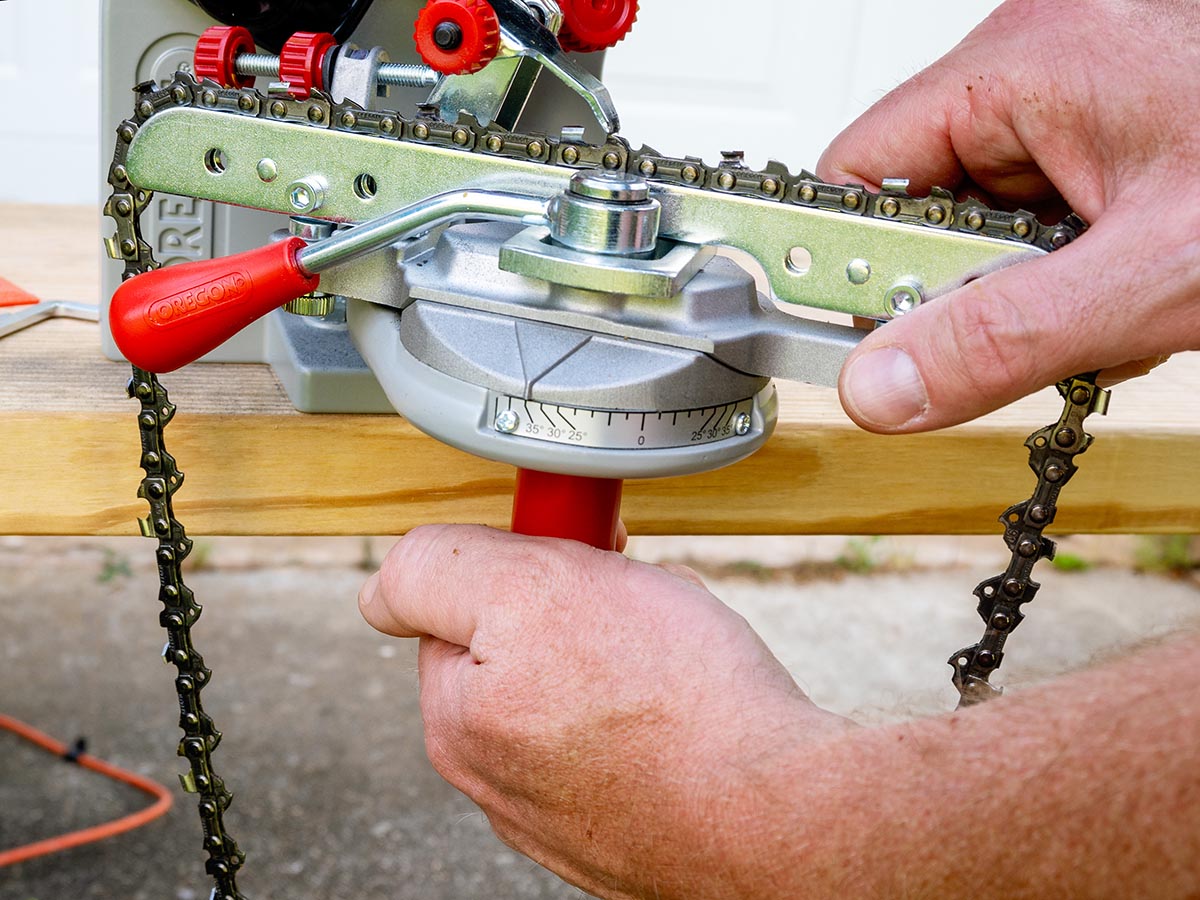
Is the Oregon 410-120 chain sharpener right for you?
This is one of those maintenance tools that is nice to have, but not every chainsaw owner wants or needs it. If your saw sits in the garage for 11 months until you need it once a year to cut down a Christmas tree, then buying a big, expensive chain grinder makes no sense. Even regular chainsaw users might decide that they are better served with regular use of a round file and occasional professional chain sharpening.
The best use case for the Oregon 410-120 chainsaw sharpener is for busy, frequent chainsaw users. The more often you sharpen your chains, the more time and productivity benefits you get from owning your own pro-quality grinder. It has the potential to minimize downtime, maximize chain life, improve your saw’s fuel efficiency, and reduce the physical strain inherent to chainsaw use. If that sounds like something you need, then you will probably love this tool.
Where to Buy the Oregon 410-120 Bench Grinder Chain Sharpener
Get the Oregon 410-120 bench grinder chain sharpener at:
Meet the Tester
Mark Wolfe is a writer and product tester with an extensive background in the nursery and landscaping industry. For more than 20 years he mowed, edged, planted, pruned, cultivated, irrigated, and renovated beautiful landscapes. Now he tests and writes reviews about the latest outdoor power equipment, hand tools, lawn care products, and other outdoor living goods.

